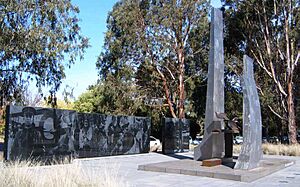Royal Australian Air Force Memorial facts for kids
The Royal Australian Air Force Memorial is a special place in Canberra, Australia's capital city. It sits on Anzac Parade, which is a main street with many memorials. This memorial honors the brave people who have served in the Royal Australian Air Force (RAAF).
The RAAF was officially formed on March 31, 1921. Before that, Australian airmen flew as part of the Australian Flying Corps during World War I. This memorial was built to celebrate the RAAF's 50th birthday. It was officially opened by Prince Philip, Duke of Edinburgh on March 15, 1973.
Later, the memorial was updated with three new walls made of black granite. These new parts were dedicated in 2002. Important leaders like Peter Hollingworth, who was the Governor-General of Australia, and John Howard, who was the Prime Minister of Australia, were there. The head of the Air Force, Angus Houston, was also present.
The Memorial's Design and Meaning
The Royal Australian Air Force Memorial is made up of two main parts. Each part tells a story about the RAAF and its members.
The Central Sculpture
The main sculpture was created by an artist named Inge King. It was unveiled in 1973. This sculpture shows the hopes and achievements of the RAAF. It has three shapes that look like upturned wings. These shapes stand for the strength, courage, and endurance of RAAF members. In the middle, a bronze sculpture shows how people have worked hard to fly and explore the skies.
At the base of the sculpture, you can read the RAAF's motto: "PER ARDUA AD ASTRA." This is a Latin phrase that means "Through struggle to the stars." It reminds everyone that great things come from hard work and determination.
The Granite Walls
The three black granite walls at the back of the memorial were designed by Robert Boynes. They were added in 2002. These walls have images and words from a poem called High Flight by John Gillespie Magee Jr. They represent the service and sacrifice of all RAAF personnel. This includes the more than 14,000 people who have lost their lives while serving. The back of the two shorter walls lists the RAAF's many battle honors. These honors show the important battles and operations the RAAF has been part of throughout its history.


